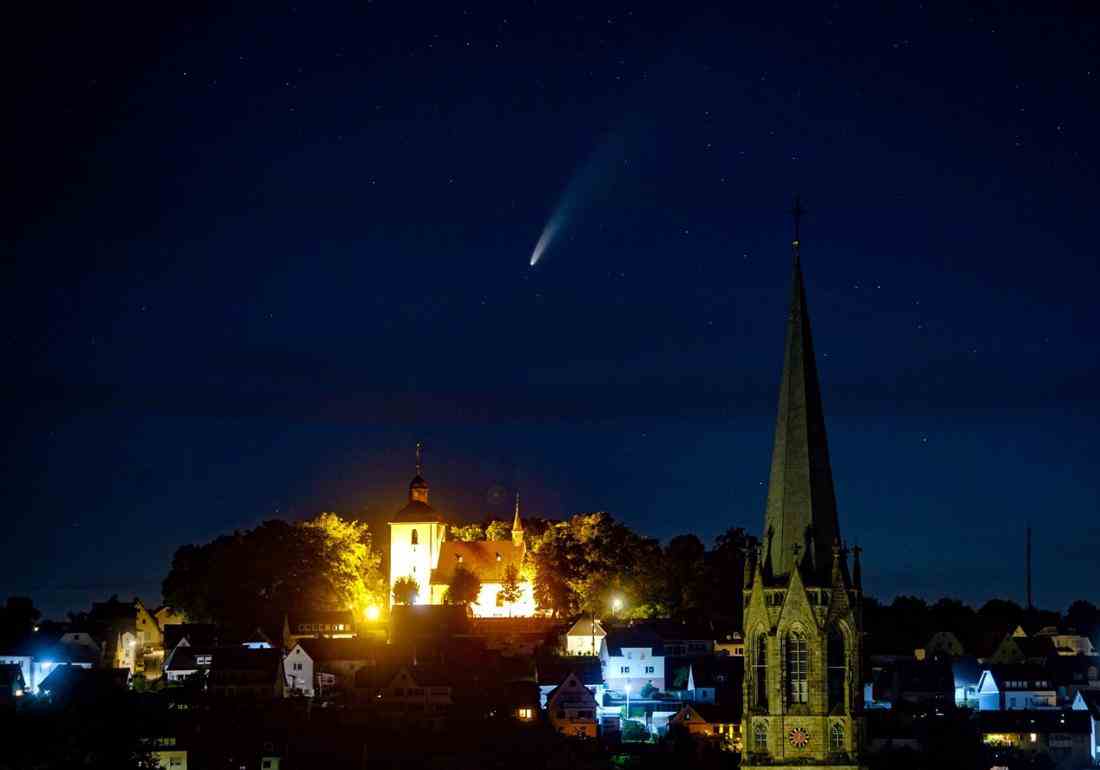Comet C/2022 E3 (ZTF) is approaching Earth. With a bit of luck you can spot it in the sky with the naked eye. When, where and how? All info.
Hamm – Do you remember Neowise? In the summer of 2020, Comet C/2020 F3 could be seen in the sky for days and especially in North Rhine-Westphalia clearly visible. You could marvel at the tailed star with the naked eye. In January and February 2023 another comet approaches the earth. Comet C/2022 E3, which bears the abbreviation ZTF. When and how interested parties can best observe the sky spectacle, we summarize in an overview.
| What | comet |
| Surname | C/2022 E3 (ZTF) |
| date of discovery | March 2, 2022 |
| explorer | Zwicky Transient Facility at Palomar Observatory |
Comet C/2022 E3 (ZTF): When and how to see it in the sky
Comet C/2022 E3 (ZTF) was discovered on March 2, 2022. It will reach its perihelion, i.e. its closest point to the sun, on January 12, 2023. After that it gets exciting, because then the C/2022 E3 (ZTF) moves towards the earth – and could be visible to us until mid-February.
According to NASA, Comet C/2022 E3 (ZTF) can initially only be observed in the northern hemisphere with binoculars or a small telescope in the morning sky. Over time, however, it will remain high in the sky near North Star throughout the night. Interested parties must therefore direct their gaze to the north.
Comet C/2022 E3 (ZTF) visible in the sky — good time on new moon
A good time to watch the comet is at new moon on January 21, 2023 beingalmost the opposite of Full moon that shone on January 7th. The moon is between the earth and the sun. In this position, exactly the half of the moon that is turned away from the earth is illuminated. So we don’t see the moon — and the night stays mostly dark. Comet C/2022 E3 (ZTF) is particularly good to admire at new moon.
According to the Haus der Astronomie, the days after that, i.e. shortly before the end of January, will also be optimal: “The comet has almost reached its maximum brightness at approx. 5.5 mag, and the moon in the first quarter sets in the second half of the night ‘ according to the experts.
Comet C/2022 E3 (ZTF): “You have to know exactly where to find it in the sky”
The maximum brightness of 5.5 mag is quite remarkable for a comet, under very dark skies you might even be able to see it with the naked eye. “But you have to know exactly where to find it in the sky.” They can help with that Search cards of the Association of Star Friendsa star atlas or corresponding mobile phone apps.
Comet C/2022 E3 (ZTF): It will make its closest approach to Earth on February 1, but…
At the February 1st there are only 42 million kilometers between the comet and the earth. Then he is in the constellation Giraffe. One might think that this is the best time to be able to see C/2022 E3 (ZTF) in the sky. However, the moonlight will interfere with the observation — the full moon is on February 5th.

However, those who missed comet C/2022 E3 (ZTF) at the end of January will have another chance to take a look at it in February. “The second week of February offers another observation window in the evening sky; C/2022 E3 is then about 6 mag bright,” explain the experts from the Haus der Astronomie. In addition, an exciting encounter can be observed with a small telescope: On February 10th and 11th C/2022 E3 will pass close to Mars.

New comet in the sky: According to experts, not comparable to “Neowise”.
However, there is no damper for astronomy fans: According to the Austrian comet photographer Michael Jäger, a show as delivered by comet C/2020 F3 (Neowise) in summer 2020rather not to be expected: “This comet cannot be compared with the bright comets, such as Neowise 2020”, said the comet expert in an interview with fr.de.

